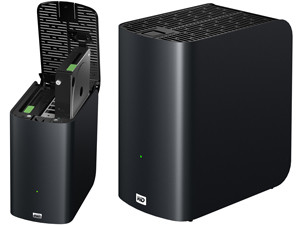
WD's My Book Live Duo is a NAS box with server smarts and cloud integration, and makes some lofty promises. We tested the 4TB version, retailing for R4 000.
Most importantly, this is not an external drive. If you're looking at rands per terabyte, stop reading now: for the price, you could probably get more than double the same capacity elsewhere. For roughly the same money, if you wanted a storage server, you could buy a micro-server, pack it with drives, and run FreeNAS. What makes WD's offering attractive is its network software, in particularly its cloud integration.
The My Book Live Duo is a neat black box with a top lid exposing two drives. It comes in 4, 6 and 8Tb varieties, each one using two drives with half the rated capacity. By default, it ships with a single storage volume spanned across both drives, but the device offers software-enabled RAID-1, mirroring the drives and effectively halving the capacity while providing peace of mind for drive failure. RAID, it must be stressed, is not a backup solution. You should still create external backups and take them somewhere safe. But it is nice to know that live data won't be lost if a drive melts down at an inopportune moment.
On the back of the unit are just three ports - a power inlet, a Gigabit Ethernet port, and a USB 2.0 port. And the front sports a single LED, which lights up in different colours to indicate activity or problems. The clean design is immediately attractive - we're just surprised there's no white version to appeal to the Apple crowd.
Inside, it's basically a little server running Linux on an 800MHz CPU. It offers a Web interface for management, FTP access for file transfers (but no SFTP, natch), and CIFS - Windows filesharing.
The management interface is slick, with tabs allowing services to be enabled and configured. By default, the whole drive is shared publicly on the network, but you can easily create users and restrict access to shares. There's no support for external user directories, though, so if you have lots of users, you'll be creating them all one by one.
In summary
Pros: Reliable RAID NAS with cloud goodness Cons: No USB 3 or wireless. Some management glitches. Price: R3 999 (4TB), R4 899 (6TB)
Most of the management tasks are very simple, and basic help popups are helpful for the more advanced remote access services. There are times where the black box approach lets it down, though, and the system doesn't do a great job of recovering. If the software on the CD can't find the drive on the network, you're basically just out of luck. The manual doesn't even detail a way to connect the drive to a PC directly, though it's certainly possible. Reconfiguring the drives for RAID was also a non-starter - the unit gave us a vague error number and, well, that was that.
The USB port on the back mounts a connected external drive, which is very handy for expanding storage and backups, but there's only one port, and it's not fast USB 3.0. Some basic access controls can be set for external drives, but mostly, it's just a handy way to get external storage on the network.
Backup software is included for scheduled backups of PCs on the network. And media streaming is built in, allowing a user to stream movies and music from the device across the network.
But where things get interesting is online. The My Book products include free subscription to Western Digital's WD 2go personal cloud service, which essentially creates a gateway allowing users to access devices from the Internet at large. Similar to remote access services like GoToMyPC, WD 2go maintains an active connection from the device, and then exposes that to Internet-connected devices, including remote PCs and mobile devices.
So one can access their files from a smartphone, and even stream media from it, as well as sharing data with other users. It's like a personal Dropbox, only under your control and vastly bigger. That's the part where the price of the box makes sense: you can get cheaper storage, and probably build a storage server yourself, but the cloud service is easy and it works well across every major smartphone brand and Web browser. It's not unique - other manufacturers have similar products - but the basic principles are solid.
Room for improvement
We'd have liked to see a few extras to really give the My Book two thumbs up. Wireless networking would be a great addition, even if it were via a separate dongle. ("Plug it into your wireless device" makes a lot of assumptions about the end user.) More than one USB port would be nice too - rotating multiple USB drives for backups is a common enough need, and not having to yank out other drives while you're doing it would be a plus. And the lack of USB 3 is just bizarre. We're talking about a device designed to manage multiple terabytes here. Moving that amount of data over USB 2.0 is not going to be pretty.
And since the system apparently runs Linux, there's quite a lot of basic functionality that could be enabled without the developers breaking much of a sweat, like a print server or integration with Active Directory for permissions.
But those limitations aside, this is a good, solid performer that achieves what it promises: reliable storage with cloud integration.
Share